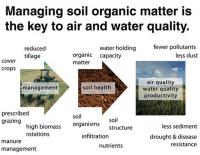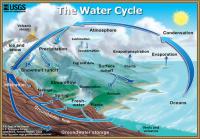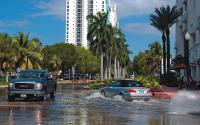-
Underestimate global warming by exaggerating cloud “brightening”
As the atmosphere warms, clouds become increasingly composed of liquid rather than ice, making them brighter. Because liquid clouds reflect more sunlight back to space than ice clouds, this “cloud phase feedback” acts as a brake on global warming in climate models. Researchers at Lawrence Livermore National Laboratory and Yale University have found, however, that climate models are aggressively making clouds “brighter” as the planet warms. This may be causing models to underestimate how much global warming will occur due to increasing carbon dioxide.
-
-
Soil’s carbon storage could help limit impact of climate change

Soils currently lock away around 2.4 trillion tons of greenhouse gases, which are stored underground as stable organic matter. Researchers say the world’s soils could store an extra eight billion tons of greenhouse gases, helping to limit the impacts of climate change. Growing crops with deeper root systems, using charcoal-based composts, and applying sustainable agriculture practices could help soils retain the equivalent of around four-fifths of annual emissions released by the burning of fossils fuels, the researchers say.
-
-
Water cycle instability posing major political and economic risks: UN experts

The current instability and unpredictability of the world water cycle is here to stay, making society’s adaptation to new risks a vital necessity when formulating development policies, a UN water expert warns. “What we haven’t understood until now is the extent to which the fundamental stability of our political structures and global economy are predicated on relative stability and predictability of the water cycle — that is, how much water becomes available in what part of the year. As a result of these new water-climate patterns, political stability and the stability of economies in most regions of the world are now at risk,” the expert says.
-
-
Tougher steel could be used for body armor, shields for satellites

A team of engineers has developed and tested a type of steel with a record-breaking ability to withstand an impact without deforming permanently. The new steel alloy could be used in a wide range of applications, from drill bits, to body armor for soldiers, to meteor-resistant casings for satellites.
-
-
Renewables and nuclear no substitute for carbon dioxide disposal
Oxford scientist argues that there are only two things we can affect with policies today that will really matter for peak warming: reducing the cost of large-scale capture and disposal of carbon dioxide, and maximizing the average rate of economic growth we achieve for a given rate of emission in the meantime.
-
-
Islamist radicals from Muslim countries tend to have engineering qualifications
Islamist radicals born and educated in Muslim countries are seventeen times more likely to have an engineering qualification than the general population in these countries. A new book, which relies on a study of over 800 members of violent Islamist groups, challenges a widely held view that many terrorists are “poor, ignorant and have nothing to lose,” according to its authors. “There is little doubt that violent Islamist radicals are vastly more educated than the general population born and educated in the Muslim world, and engineers are dramatically over-represented,” the authors say.
-
-
Flooding, accelerated sea-level rise in Miami over last decade

Miami Beach flood events have significantly increased over the last decade due to an acceleration of sea-level rise in South Florida. Scientists suggest that regional sea-level projections should be used in place of global projections to better prepare for future flood hazards in the region.
-
-
Global warming of 2.5°C degrees would put at risk trillions of dollars of world’s financial assets
An average of $2.5 trillion, or 1.8 percent, of the world’s financial assets would be at risk from the impacts of climate change if global mean surface temperature rises by 2.5°C (4.5°F) above its pre-industrial level by 2100, according to a new study. that the authors found, however, that uncertainties in estimating the “climate Value at Risk” mean that there is a 1 percent chance that warming of 2.5°C could threaten $24 trillion, or 16.9 percent, of global financial assets in 2100.
-
-
California drought patterns becoming more common

Atmospheric patterns resembling those that appeared during the latter half of California’s ongoing multi-year drought are becoming more common. The current record-breaking drought in California has arisen from both extremely low precipitation and extremely warm temperature. The new study found clear evidence that atmospheric patterns that look like those seen during this extreme drought have in fact become more common in recent decades.
-
-
Analyzing the effects of rising sea levels in Norfolk, Va.
In Norfolk, Virginia, an East Coast city which is home to the world’s largest naval station and important seaports, catastrophic flooding could damage more than homes and roads. A new study from Sandia National Laboratories assesses how much the city, its region, and the nation would suffer in damages to national assets and lost economic activity if it does nothing to address rising sea levels. The analysis method is available to cities that want to become more resilient.
-
-
Rapid Antarctica ice melt: Sea-level rise nearly double over earlier estimates
A new study suggests that the most recent estimates by the Intergovernmental Panel on Climate Change for future sea-level rise over the next 100 years could be too low by almost a factor of two. The researchers incorporated into their models mechanisms that were previously known but never incorporated in a model like this before, and added them to their ice-sheet model, so they could consider the effects of surface melt water on the break-up of Antarctica’s ice shelves and the collapse of vertical ice cliffs.
-
-
Starvation is only one crop breeding cycle away
Global population growth, urbanization, and a changing climate mean staple food crops will need to achieve much higher yields in the near future. New research proposes genetic engineering solutions to improve photosynthetic efficiency of food crops, boosting yield under higher temperatures and carbon dioxide levels. Because it can take twenty to thirty years of breeding and product development efforts before new crops are available to farmers, those efforts must start now.
-
-
Laser cloaking device to help us hide Earth from aliens
Several prominent scientists, including Stephen Hawking, have cautioned against humanity broadcasting our presence to intelligent life on other planets. Two astronomers suggest humanity could use lasers to conceal the Earth from searches by advanced extraterrestrial civilizations.
-
-
Flexible security solution makes life difficult for burglars
Ideally, homeowners want to be warned if a burglar sneaks onto their property, and farmers want to know if horses or sheep are no longer in the paddock or field they were left grazing in. Experimental physicists at Saarland University have developed a flexible security solution that can be used in gardens, driveways, business premises, or on grazing land and in woodland.
-
-
DARPA’s seeking innovative system-level technologies
DARPA’s Tactical Technology Office (TTO) focuses on developing and demonstrating innovative system-level technologies and prototypes that incorporate new and emerging technologies, for the purpose of preserving and extending U.S. military advantages over potential adversaries. To help accomplish these goals and inform potential performers about TTO’s technical objectives, TTO has scheduled its fourth annual Proposers Day for Wednesday and Thursday, 20 and 21 April 2016.
-
More headlines
The long view
A Shining Star in a Contentious Legacy: Could Marty Makary Be the Saving Grace of a Divisive Presidency?
While much of the Trump administration has sparked controversy, the FDA’s consumer-first reforms may be remembered as its brightest legacy. From AI-driven drug reviews to bans on artificial dyes, the FDA’s agenda resonates with the public in ways few Trump-era policies have.
Risk Assessment with Machine Learning
Researchers utilize geological survey data and machine learning algorithms for accurately predicting liquefaction risk in earthquake-prone areas.
Foundation for U.S. Breakthroughs Feels Shakier to Researchers
With each dollar of its grants, the National Institutes of Health —the world’s largest funder of biomedical research —generates, on average, $2.56 worth of economic activity across all 50 states. NIH grants also support more than 400,000 U.S. jobs, and have been a central force in establishing the country’s dominance in medical research. Waves of funding cuts and grant terminations under the second Trump administration are a threat to the U.S. status as driver of scientific progress, and to the nation’s economy.
The True Cost of Abandoning Science
“We now face a choice: to remain at the vanguard of scientific inquiry through sound investment, or to cede our leadership and watch others answer the big questions that have confounded humanity for millennia —and reap the rewards.”
Bookshelf: Smartphones Shape War in Hyperconnected World
The smartphone is helping to shape the conduct and representation of contemporary war. A new book argues that as an operative device, the smartphone is now “being used as a central weapon of war.”
New Approach Detects Adversarial Attacks in Multimodal AI Systems
New vulnerabilities have emerged with the rapid advancement and adoption of multimodal foundational AI models, significantly expanding the potential for cybersecurity attacks. Topological signatures key to revealing attacks, identifying origins of threats.
